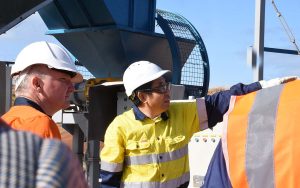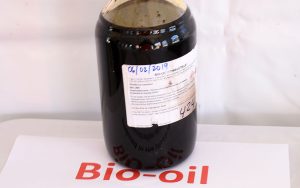Renergi installs innovative biomass pyrolysis plant
From start-up inception in 2012 to the verge of plant operation in 2023, ARENA has supported biomass-to-energy company Renergi along its renewable energy journey.

“Installation is a dream partially come true, but the completion of commissioning will mean the dream has actually come true.” – Dr Chun-Zhu Li
The story of Western Australian bioenergy company Renergi has been a journey from university laboratory via spin-off company, through research and development, on to building, testing, proving and now commercial installation.
Along the way, ARENA has provided support for each step of development.
In 2009, the Federal Government provided $2.5 million funding for a Sustainable Production of Transport Biofuels project led by then John Curtin Distinguished Professor Chun-Zhu Li at Curtin University in WA.
By 2012, the project reported success from combining heating (pyrolysis) of agricultural waste and processing (biorefinery) to produce advanced biofuels.
Along the way, the team filed two patent applications derived from their work.
Then, in late 2012, Dr Li with his colleagues at Curtin University created Renergi. The private company aimed to develop and commercialise renewable energy technologies.
From the laboratory to the field

With the help of $5.47 million funding through ARENA’s Emerging Renewables program, Curtin University got to work on a Low Emission Biofuel Technology project.
The aim? To demonstrate in a practical setting that their pyrolysis process could successfully transform agricultural waste into a renewable fuel.
“The purpose of the original project was to produce a second-generation biofuel … which can be added to diesel and petrol,” Dr Li said.
“We developed a pyrolysis technology called grinding pyrolysis.”
Renergi’s innovative approach added metal grinding balls with the biomass into a spinning reactor vessel. Thousands of balls of various sizes help to break up the biomass during the 400 to 500 ºC pyrolysis process. But Dr Li said they also perform a more subtle action.
“For large particles going into the reactor, the external surface will be heated up initially, converting the biomass into biochar, bio-oil vapour and non-condensable gas,” Dr Li said
“And then the grinding action will quickly remove the biochar layer to expose more biomass surface area. In this way, large particles can be quickly pyrolysed.”
As then ARENA CEO Ivor Frischknecht said at the time: “These projects demonstrate how ARENA’s unique role supports renewable energy technologies across the innovation chain, advancing them from the laboratory to the field.”
Renergi’s latest project scales the reactor to a commercial scale.
Commercial potential

Continuing from a demonstration-stage project, the current project in Collie is supported by $2 million from the WA Government’s Collie Futures Industry Development Fund and $3.9 million funding from ARENA (later increased to $4.3 million due to rising costs during the COVID crisis). Renergi says the new plant will process municipal solid waste and other biomass, including forestry waste.
Installed in the Shire of Collie in Western Australia, Renergi’s demonstration operation will produce bio-oil, biochar and wood vinegar. All have commercial value.
Bio-oil can be used to fuel electricity generation or refined to produce a renewable component of future aviation fuels, while biochar has many applications, from agriculture to construction, says Dr Li.
“One is to put it directly into the soil as a soil conditioner,” he said.
“Alternatively, you can give the biochar to animals such as cows and sheep as a food supplement. The biochar is then returned to the soil in animal manure.
“And when you return the biochar to the soil directly or in manure, you actually have a safe carbon sequestration.”
“The biochar can also be used as a material in road construction. And that’s again, a safe sequestration of carbon.”
A third product is wood vinegar, which has agricultural and horticultural applications as a fertiliser, and as a pesticide.
What now for Renergi?

Renergi has also attracted investment from a consortium linked to Sunshot Energy, co-owned by notable climate economist Professor Ross Garnaut. Professor Garnaut is now a director at Renergi.
The consortium is backing the future commercialisation of the Renergi technology at other regional locations around Australia. Councils are expected to be key customers.
Renergi says Collie Shire’s single plant will every year convert all of its combustible portions of municipal solid waste and about 25,000 tonnes of biomass (including forestry waste) into bio-oil and biochar.
“A council could just buy equipment and operate themselves, or we can operate for them,” Dr Li said.
ARENA has also funded other bioenergy projects.
Sydney Water’s Malabar wastewater treatment plant in 2020 received $5.9 million to demonstrate upgrading biogas to biomethane suitable for injection into the gas distribution network.
In 2022, Logan City Council in south-east Queensland opened a $28 million Biosolids Gasification Facility. ARENA in 2019 committed $6.2 million towards the then $17.3 million project.
Renergi marked the completed installation of its Collie plant in April 2023.
Dr Li says the last step in the long journey from university laboratory to full operation will be the final commissioning of the plant.
“Installation is a dream partially come true, but the completion of commissioning will mean the dream has actually come true.”
LIKE THIS STORY? SIGN UP TO OUR NEWSLETTER

ARENA